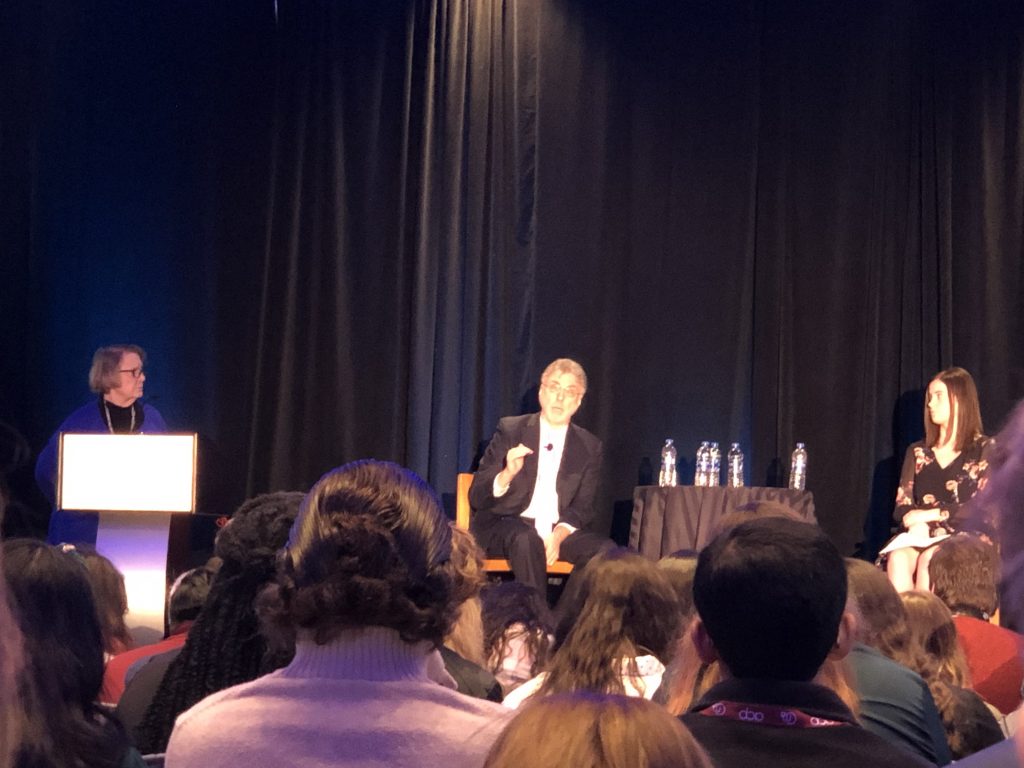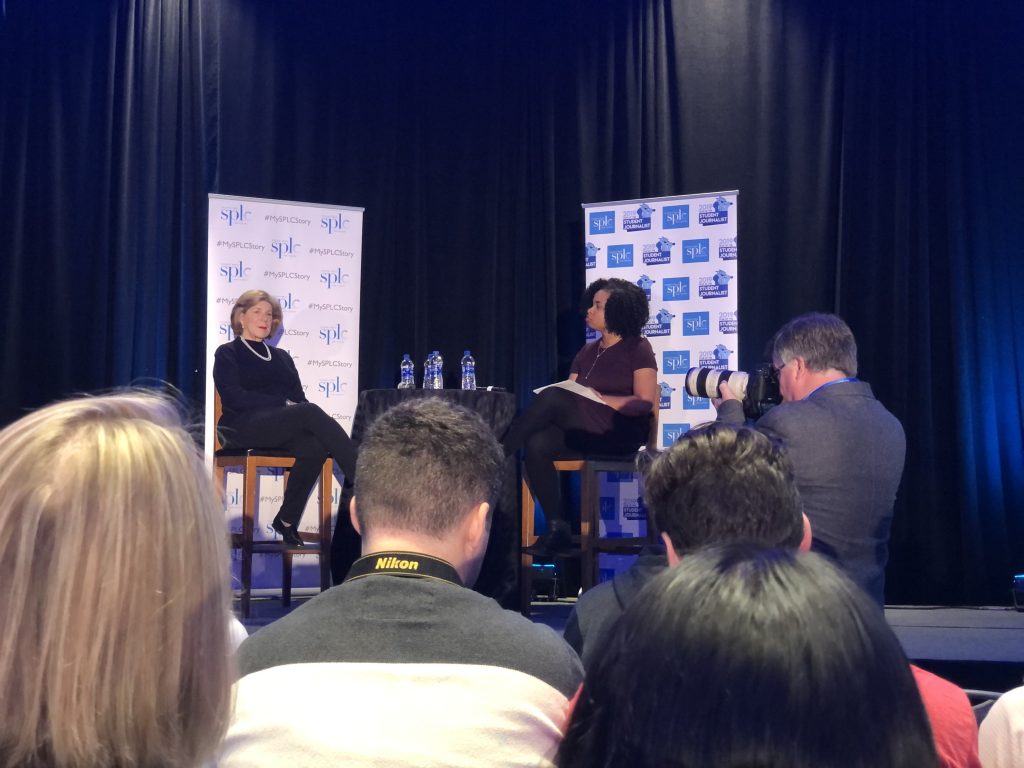November 8, 2019
National College Media Convention Takes Over Washington D.C.

By: burgundy bug
National College Media Convetion Takes Over Washington D.C.
Source: The Burgundy Zine
Over 1,600 student journalists and their advisors swarmed around the National College Media Convention in Washington D.C. on Oct. 31 through Nov. 3.
More than 275 sessions were held by representatives from major media organizations, such as National Geographic. Keynote speakers included Washington Post editor Marty Baron, National Public Radio legal affairs correspondent Nina Totenberg, CNN White House correspondent Abbey Phillip, and Capital Gazette editor Rick Hutzell.
Attendees from coast to coast of the United States came to learn more about all aspects of the journalism industry, whether they were aspiring reporters, graphic designers, or photojournalists.
Students and advisors alike came equipped with a pen and paper, while others were sporting Canon, Nikon, or Sony cameras. The audiences at each session consistently appeared to be about a 60:40 split of young women and men.
The convention kicked off on Thursday night with registration and pre-convention sessions that detailed covering elections, how to use various Google tools, in addition to discussions on podcasting and video storytelling.
Sessions ran from 9:00 A.M. to 4:20 P.M. Friday and Saturday, then 9:00 A.M. to 12:00 P.M. on Sunday.
During National Geographic’s session on Friday morning, creative director Emmett Smith stressed the importance of photography in the media industry.
“Drive stories with images.”
Emmett Smith
Most of the photographers and storytellers featured in National Geographic are contracted or freelance journalists, rather than full-time staff, Smith explained.
“We have two staff photographers,” he said. “Those who work on contract own their images, which isn’t something you always see at other publications.”
While National Geographic is renowned for its stunning photography, a photograph didn’t appear on the cover of their publication until 1959, 71 years after they were founded, as stated on their website.
Smith said photo covers didn’t become a staple of their magazines until the ’80s. The style of their magazines that developed throughout the ’90s is much closer to what viewers recognize as National Geographic today.
Marty Baron Interview
Marty Baron answers questions from student journalists at the National College Media Convention.
Source: Washington D.C. Through the Eye of an iPhone | Penelope Peru Photography
During the keynote on Friday, Shannon Mason, a junior at The King’s College, and Marissa Payne, a senior at University of Iowa, interviewed Baron.
Hundreds upon hundreds of heads were cocked up in the audience, their gaze fixed on Baron as Mason and Payne asked him various questions about his experiences in the news industry.
First, the students asked Baron about his perspective on President Donald Trump’s negative view of the press.
Baron began with the historic strife between the press and presidents that dates back far beyond the Trump administration, concluding that a president’s distrust in media isn’t a new issue.
“Debate makes a democracy healthy.”
Marty Baron
“Other people can do the name-calling; we’ll do the fact-finding,” Baron said. “If we were in the business of fake news, we wouldn’t need 850 people in our newsroom.”
Then, Baron discussed the importance of the news relating to everyday individuals.
“People need to see fair representations of themselves in the news,” he began. “…You have to signal your opposition without telling people they can’t speak.”
When asked about what it’s like to work at The Washington Post, Baron said it’s not a nine-to-five job with some reporters continuing their work overnight. In particular, political journalists are “never really done their job for the day,” he continued.
“The best answer to any question is ‘yes,'” Baron explained. “We want to see creativity, curiosity, rigor.”
Baron appeared deep in thought when the students asked him what piece of advice he would give to his former self during the beginning of his career.
“I wish I had known how little I’d be paid [laughs],” Baron said after awhile. “But, being the editor at my college paper was great prep for the rest of my career.”
Then, the students asked Baron about The Washington Post being “owned by Amazon.”
“We’re not owned by Amazon, we’re owned by Jeff Bezos, the founder of Amazon,” Baron corrected. “Bezos hasn’t interfered at all with our stories.”
Before members of the audience were invited to ask Baron questions, the students wrapped up their interview by asking him about the dangers that come with being a journalist.
Baron didn’t sugarcoat the risks of being a reporter. He talked about the journalist who was kidnapped in Syria, the correspondent kept in “one of the worst prisons” in Iran for 447 days, and the journalist who was dismembered in the middle east.
Catherine Straub’s “Creating the Cover” was the last session we attended on Friday. Straub began her presentation with the importance of the “three second test.”
The three second test is a magazine standard to make sure the point of your issue is clear and grabs the readers attention in “three seconds” as they’re gazing at a magazine rack.
Straub stressed the importance of sticking to a single message, starting the cover early during the magazine design process, and sticking to a consistent look.
“Cover blurbs shouldn’t distract from the main image and blurb,” Straub said. “You need to sell your message.”
Straub also said it’s important not to cover your magazine’s logo unless you’re a long-established and recognizable brand.
On Saturday morning, The Washington Post art directors Kathy Lee and Lizzie Hart discussed “What It Takes to Make It as a Designer in the Nation’s Capital.”
Lee and Hart showed samples of their work in The Washington Post and encouraged the audience to collaborate with illustrators and photographers for their work.
Interview with Nina Totenberg
Nina Totenberg shares her story during the National College Media Convention.
Source: Washington D.C. Through the Eye of an iPhone | Penelope Peru Photography
During the first keynote on Saturday, Totenberg was interviewed about her experiences in the news industry, particularly focusing on her work with justices of the United States Supreme Court.
“I wanted to be Nancy Drew.”
Nina Totenberg
Totenberg began with the lack of women in the fields she was interested in: there were no women detectives, no women police officers.
Her career in journalism began with her fascination of government. After reading Teddy White’s book, “The Making of the President,” Totenberg was inspired to “be a witness of history.”
“I was the only woman [reporter] for the first 10 years of my career.”
Nina Totenberg
However, news organizations began hiring more and more women because they realized women would work for a lower wage during that era, Totenberg explained.
“NPR was female dominated,” she said. “Our male colleagues would refer to us as ‘the fallopian jungle’ … We thought it was funny at the time, but it wasn’t respectful.”
Then, Totenberg discussed her friendship with Ginsberg over the last half-century, the importance of building relationships, and how the SCOTUS continues to change over time.
“Justices didn’t write books or do interviews until 10-15 years ago,” Totenberg began. “Now they do interviews to promote their books [laughs].”
Totenberg also mentioned the relationship between justices and how Anton Scalia had a way of keeping the peace prior to his passing.
“To know justice Scalia was to love him, in a lot of ways,” Totenberg said. “When he died, a lot of the life went out of the [Supreme Court].”
In regards to the current state of the SCOTUS, Totenberg said we can expect a “profound change in law over the next 10 years.”
Totenberg offered predictions on how the justices’ upcoming rulings could negatively affect members of the LGBTQ community seeking employee rights, the possibility of Roe v. Wade being “reversed” (which would affect abortion rights), and how religion cases could be “emphasized with free exercise.”
She also discussed how upcoming SCOTUS rulings could affect firearms legislation and Deferred Action for Childhood Arrival recipients.
Read: Dear America: A Review of Jose Antonio Vargas’ Notes of an Undocumented Citizen
Source: The Burgundy Zine
In Conclusion
The National College Media Convention hosted by the Associated Collegiate Press and College Media Association at the Grand Hyatt in Washington D.C. contained a wealth of information and inspiration for journalism students and their advisors alike.
Leading industry professionals provided insight from their lifelong careers while simultaneously shedding light on the future of the press as they “passed the torch” to young reporters, editors, and graphic designers.
The next National College Media convention will take place in Manhattan, N.Y. in March 2020, according to the College Media Association.
Interested in having content featured in an upcoming blog post or issue of The Burgundy Zine? Head on over to the submissions page!
For all other inquiries, please fulfill a contact form.
This entry was posted in Blog, Advice, Hot Stuff, 2019, Fall 2019, November 2019, Blog, Politics, Blog, Travel, Washington D.C. and tagged in #collegemedia2019, acp cma washington d.c., acp washington d.c., blog, blogging community, blogs, burgundy zine, burgundyzine, burgundyzine.com, catherine straub, catherine straub drake univeristy, cma washington d.c., college media 2019, college media convention, creative director emmett smith, design, editor, editors, emmett smith, fall national college media convention, fall national college media convention 2019, graphic design, journalism, journalism convention, journalist, journalists, kathy lee, kathy lee art director, kathy lee washington post, lizzie hart, lizzie hart washington post, lizzie hart washington post art director, marty baron, marty baron interview, marty baron washington post, media industry, national college media convention, national college media convention 2019, National College Media Convention Takes Over Washington D.C., national college media convention washington d.c., national geographic, national geographic emmett smith, news, news industry, nina totenberg npr, november 2019, npr, press, reporter, reporters, the burgundy zine, the washington post, washington d.c., washington dc, writing, writing community, zine, zines.

burgundy bug
https://burgundyzine.com/about/#burgundybugA cynical optimist and mad scientist undercover, burgundy bug is the editor, graphic designer, webmaster, social media manager, and primary photographer for The Burgundy Zine. Entangled in a web of curiosity, burgundy bug’s work embodies a wide variety of topics including: neuroscience, psychology, ecology, biology, cannabis, reviews, fashion, entertainment, and politics. You can learn more about working with burgundy bug by visiting her portfolio website: burgundybug.com
View more posts from this author


